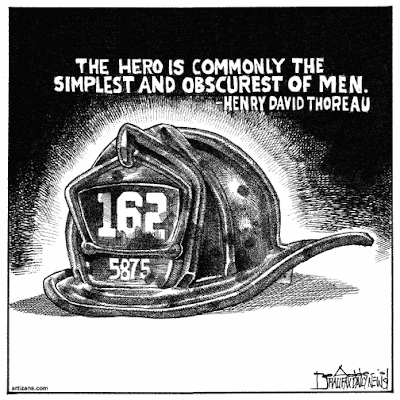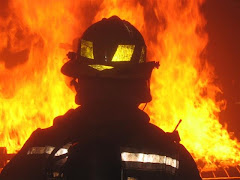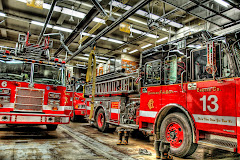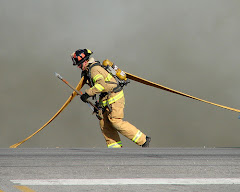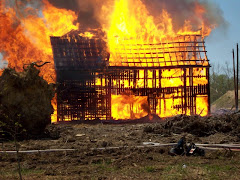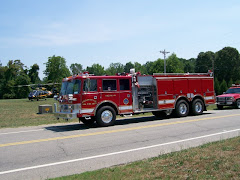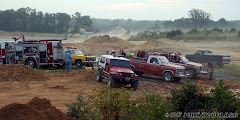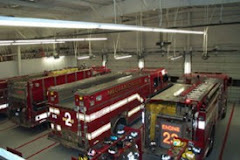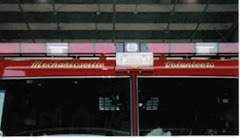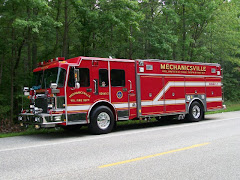Tuesday, September 25, 2007
You Might be a Firefighter if...
2. You have ever had a heated debate over the color of fire trucks.
3. You have ever spent 10 min trying to force open a door only to have someone come along and open it by turning the handle.
4. You have ever taken 10 or more showers in 1 day.
5. You lay out your cloths from that day so if there is a call at night you can find them quickly.
6. You take great joy in smashing the windows of a car parked in a fire zone or in front of a hydrant.
7. You have ever been airborne without an aircraft and water was your thrust.
8. You always wear red suspenders.
9. You have ever slept in a hosebed.
10. You carry a ton of specially modified tools in your pocket.
11. You ever cursed out someone for armor-alling the seats to make them look nice.
12. You’ve ever clung to the air horn chord for dear life because the driver is insane.
13. You have ever played jingle bells at Xmas time on the air horns to clear traffic.
14. You double your weight every time you go on a job a building.
15. You have ever said, "She’s hot tonight" and not been talking about a girl.
16. You have ever had "yoda ears"
17. You have ever called a person found after a fire a "crispy critter"
18. You have ever smoked and there wasn't a cigarette in sight.
19. You have ever stomped out a fire with your boots because you couldn't wait for water.
20. You have ever walked 3 miles into the woods in 100 degree heat in full turnout gear and a 5 gal or more water can strapped on your back just to put out a fire.
21. Your kids are afraid to get into water fights with you.
22. "Climbing the corporate ladder" has nothing to do with career advancement.
23. Your work gear makes you sound like Darth Vader.
24. You roll around in anything that just burned to make your new gear look old.
25. You take pride in the fact that you haven't washed your gear in years.
26. You carry enough in your pockets to give the Swiss army knives competition.
27. You carry enough in your car to extinguish a minor blaze.
28. You have ever juggled hot coals with your gloves.
29. Your own vehicle has more lights than a Christmas tree.
30. All the shirts you own say you are a firefighter.
31. You find yourself living at the fire department 365 days a year!
32. When you go to rent a movie, and they insist on getting Backdraft EVERY TIME!
33. At 3:00am you get back from a bad fire, you walk through the house and test the smoke alarms.
34. If you have more pagers than money in your wallet.
35. If you can’t walk through a building with out looking for the fire extinguisher.
36. If a great stop has nothing does with a moving vehicle.
37. If assembling a mile and a half of hose to catch fire in running up hill is a good day.
38. The microwave goes off and you run out of the house thinking it was your pager.
39. You ever tried to patent a 911 blocker with the phone Company
40. If you can hear that the siren will go off even before your dog notices it.
41. If you have ever woken up thinking your pager went off and as you look at it, it goes off
42. If you have ever tested your gloves by putting a fuzzie out on your hand.
43. If you have ever been awakened with a CO2 extinguisher
44. If you have ever dried your gloves on the trucks exhaust
45. You know you're a firefighter when you really think that rusty old hydrant looks good in the garden. :)
46. All your friends give you t-shirts from their departments for your birthday, Christmas, anniversary, etc.
47. If your wife voluntarily chooses the lumpy side of the bed to avoid being trampled in route to a call!
48. Your wife/girlfriend has learned to duck and cover when she hears the pager go off for fear of being run down.
49. If you had to extricate someone by cutting the car doors off on one side and realized there was nothing wrong with the doors on the other side.
50. If you have more toy fire trucks than your kids do.
51. When you have ever made a Jacuzzi out of a 2100 gallon dump tank and a rescue boat motor (15 horse Merc). ..It was hot!.............Watch yer toes!
52. When you take all of your important stuff (like wallets and pagers) out of your pockets before going to a training involving a portable tank.
Thursday, September 20, 2007
Sunday, September 16, 2007
Wednesday, September 12, 2007
Firehouse Humor
Years ago, when I was working on a small town ambulance, it was not uncommon for my wife and me to stop at the local grocer to buy food for dinner after a call. I had gone in to get a head of lettuce and some apples. Unknown to me the floor was wet from the newly installed produce sprayers. Down I went, hitting my head hard. When I came to, the manager of the store was sitting beside me telling me not to move, that he had called 911. At the same time my pager went off and he looked at me and asked, “What was that? I said "My pager, I am 911." He looked at me, shocked " Boy, you guys are fast!"
The Ten Commandments of Rolling Code
1. Thou shall treat thy pumper as though it were your firstborn child.
2. Blow thy siren and shine thy light with great vigor enroute.
3. Know where thy goest at all times.
4. Be certain all those in attendance are affixed prior to venturing forth.
5. Thou shall arriveth shiny side up.
6. Be ever so humble when thy mic is keyed.
7. Thou salt not leave thy station 'til thy door is openeth.
8. Thou salt not closeth thy bay door too soon.
9. Thou salt closeth all compartment doors when thou art done.
10. Thou salt never chastise thy driver for making a wrong turn when it results in a return to the firehouse.
Firefighter Terminology
Haligan Tool: Used for breaking headlights
Water Hammer: Used to drive in water nails
Drafting: Following another fire engine really closely on the way to a fire
Backdraft: Drafting on the way back to the station
Ladder Company: Where they make ladders
Flashover: Too many lights on the pumper
Rollover: What you do in the ashes to make your new turnouts look old
Master Stream: The Mississippi River
BLEVE: It was dry when I drove my Chevy there
Mutual Aid: When 4 kids are hurt and there is only 3 band aids, someone is getting Mutual Aid
Firefighter911
Tuesday, September 11, 2007
Tuesday, September 4, 2007
343 FDNY Fire Fighters Who Died On 9/11
Adam David Rand
Alan David Feinberg
Allan Tarasiewicz
Andre G. Fletcher
Andrew A. Fredericks
Andrew Brian Jordan, Sr.
Andrew Brunn
Andrew J. Desperito
Angel L. Juarbe, Jr.
Anthony Jovic
Anthony Rodriguez
Arthur T. Barry
Benjamin Suarez
Brian C. Hickey
Brian Cannizzaro
Brian E. Bilcher
Brian E. Sweeney
Brian G. Ahearn
Brian G. McAleese
Bruce H. Gary
Calixto Anaya, Jr.
Carl E. Molinaro
Carl F. Asaro
Carl J. Bedigian
Carl V. Bini
Carlos Lillo
Charles J. Margiotta
Charles L. Kasper
Charles R. Mendez
Charles W. Garbarini
Christian Michael Otto Regenhard
Christopher Alexandra Santora
Christopher J. Blackwell
Christopher James Pickford
Christopher M. Mozzillo
Christopher P. Sullivan
Dana Rey Hannon
Daniel E. Harlin
Daniel F. Libretti
Daniel J. Brethel
Daniel O'Callaghan
Daniel T. Suhr
David Fontana
David G. Arce
David Halderman
David J. La Forge
David M. Weiss
David P. DeRubbio
David T. Wooley
Denis P. Germain
Dennis A. Cross
Dennis Lawrence Devlin
Dennis M. Carey, Sr.
Dennis M. Mulligan
Dennis Mojica
Dennis P. McHugh
Dennis P. Oberg
Dennis Scauso
Donald J. Burns
Donald J. Regan
Douglas C. Miller
Douglas E. Oelschlager
Durrell V. Pearsall
Edward Alexander D'Atri
Edward F. Geraghty
Edward J. Day
Edward J. Rall
Edward J. White, III
Eric T. Allen
Eric Taube Olsen
Eugene M. Whelan
Faustino Apostol
Fr. Mychal Judge
Frank Anthony Palombo
Frank J. Bonomo
Frank J. Callahan
Frankie Esposito
Fred C. Scheffold
Frederick J. Ill, Jr.
Gary P. Geidel
Gary R. Box
Geoffrey E. Guja
George C. Cain
George DiPasquale
Gerald T. Atwood
Gerard A. Barbara
Gerard Baptiste
Gerard J. Duffy
Gerard P. Dewan
Gerard P. Schrang
Gerard T. Nevins
Glenn C. Perry
Glenn E. Wilkinson
Gregg A. Atlas
Gregory J. Buck
Gregory M. Stajk
Gregory R. Sikorsky
Gregory Saucedo
Harvey L. Harrell
Hector L. Tirado, Jr.
Henry A. Miller, Jr.
James A. Giberson
James Amato
James M. Gray
James N. Pappageorge
James Raymond Coyle
Jay Ogren
Jeff Palazzo
Jeffrey J. Giordano
Jeffrey J. Olsen
Jeffrey P. Walz
Jeffrey Stark
Jimmy Riches
John A. Crisci
John A. Schardt
John August Santore
John Chipura
John D. Marshall
John F. Ginley
John Heffernan
John J. Fanning
John J. Florio
John J. Giordano
John J. Tipping, II
John K. McAvoy
John M. Collins
John M. Moran
John M. Paolillo
John P. Bergin
John P. Burnside
John P. Napolitano
John P. Williamson
John Patrick Tierney
John R. Fischer
John T. Vigiano II
Jonathan L. Ielpi
Jonathan R. Hohmann
Jose A. Guadalupe
Joseph Agnello
Joseph Angelini, Sr.
Joseph Anthony Mascali
Joseph D. Farrelly
Joseph E. Maloney
Joseph G. Hunter
Joseph G. Leavey
Joseph Grzelak
Joseph J. Angelini, Jr.
Joseph Maffeo
Joseph P. Gullickson
Joseph P. Henry
Joseph P. Spor
Joseph R. Marchbanks, Jr.
Joseph R. Rivelli, Jr.
Karl H. Joseph
Keith A. Glascoe
Keithroy Marcellus Maynard
Kenneth B. Kumpel
Kenneth J. Marino
Kenneth J. Phelan, Sr.
Kenneth T. Watson
Kevin C. Dowdell
Kevin H. Bracken
Kevin J. Pfeifer
Kevin J. Smith
Kevin M. O'Rourke
Kevin M. Prior
Kevin O. Reilly
Kevin W. Donnelly
Lawrence G. Veling
Lawrence J. Virgilio
Lawrence T. Stack
Lee S. Fehling
Lenny Ragaglia
Leon Smith, Jr.
Lincoln Quappe
Louis Arena
Louis J. Modafferi
Manuel Del Valle, Jr.
Manuel Mojica
Mark P. Whitford
Martin E. McWilliams
Martin J. Egan, Jr.
Martin N. DeMeo
Matthew D. Garvey
Matthew E. Barnes
Matthew L. Ryan
Matthew S. Rogan
Michael A. Esposito
Michael Boyle
Michael C. Fiore
Michael Clarke
Michael D. D'Auria
Michael Dermott Mullan
Michael E. Brennan
Michael E. Roberts
Michael Edward Roberts
Michael F. Cammarata
Michael F. Lynch
Michael Francis Lynch
Michael G. Montesi
Michael H. Haub
Michael J. Cawley
Michael J. Elferis
Michael J. Lyons
Michael J. Otten
Michael K. Healey
Michael L. Bocchino
Michael N. Fodor
Michael Paul Ragusa
Michael Scott Carlo
Michael T. Carroll
Michael T. Quilty
Michael T. Russo
Michael Thomas Weinberg
Michael Vernon Kiefer
Michael Warchola
Neil Joseph Leavy
Nicholas P. Chiofalo
Nicholas P. Rossomando
Orio Joseph Palmer
Patrick D. Byrne
Patrick J. Brown
Patrick J. Lyons
Patrick J. O'Keefe
Patrick J. Waters
Paul A. Tegtmeier
Paul G. Ruback
Paul Hanlon Keating
Paul J. Gill
Paul J. Pansini
Paul M. Beyer
Paul Richard Martini
Paul Thomas Mitchell
Peter A. Bielfeld
Peter A. Nelson
Peter Anthony Vega
Peter Brennan
Peter C. Martin
Peter J. Carroll
Peter J. Ganci, Jr.
Peter L. Freund
Peter Langone
Philip S. Petti
R. Bruce Van Hine
Raymond E. Murphy
Raymond M. Downey
Raymond Meisenheimer
Raymond R. York
Ricardo Joseph Quinn
Richard A. Prunty
Richard D. Allen
Richard J. Kelly, Jr.
Richard T. Muldowney, Jr.
Robert B. Nagel
Robert C. King, Jr.
Robert Cordice
Robert Curatolo
Robert Dismas McMahon
Robert E. Parro
Robert Edward Evans
Robert F. Wallace
Robert J. Crawford
Robert J. Foti
Robert J. Minara
Robert M. Regan
Robert T. Lane
Robert T. Linnane
Robert W. Hamilton
Robert W. Spear, Jr.
Robert William McPadden
Ronald P. Bucca
Ronald T. Kerwin
Ronnie E. Gies
Ronnie L. Henderson
Ruben D. Correa
Salvatore Calabro
Samuel P. Oitice
Scott Andrew Larsen
Scott Matthew Davidson
Scott Michael Kopytko
Sean Patrick Tallon
Sean S. Hanley
Sergio G. Villanueva
Shawn Edward Powell
Stanley S. Smagala, Jr.
Stephen E. Belson
Stephen G. Harrell
Stephen G. Siller
Stephen P. Russell
Steve J. Mercado
Steven Coakley
Steven J. Bates
Steven J. Olson
Tarel Coleman
Terence Augustine McShane
Terence S. Hatton
Terrace P. Farrell
Thomas A. Casoria
Thomas A. Gardner
Thomas C. Moody
Thomas E. Sabella
Thomas G. O'Hagan
Thomas Gambino, Jr.
Thomas Gerard Schoales
Thomas Haskell, Jr.
Thomas J. Farino
Thomas J. Foley
Thomas J. Hetzel
Thomas J. Kennedy
Thomas J. Kuveikis
Thomas J. McCann
Thomas M. Butler
Thomas Mingione
Thomas P. DeAngelis
Thomas P. Hannafin
Thomas P. Holohan
Thomas Patrick Cullen, III
Thomas Richard Kelly
Thomas W. Kelly
Timothy Brian Higgins
Timothy M. Stackpole
Timothy M. Welty
Timothy Patrick McSweeney
Timothy S. Haskell
Vernon A. Richard
Vernon P. Cherry
Vincent A. Princiotta
Vincent D. Kane
Vincent E. Brunton
Vincent F. Giammona
Vincent G. Halloran
Vincent S. Morello
Walter G. Hynes
William D. Lake
William E. Krukowski
William E. McGinn
William F. Burke, Jr.
William J. Mahoney, II
William L. Henry, Jr.
William M. Feehan
William McGovern
William R. Johnston
William S. O'Keefe
Forever in our Hearts
Tuesday, August 28, 2007
Suppressing the fuel and the energy
Often, the main way to extinguish a fire is to spray with water. The water has two roles:
in contact with the fire, it vaporizes, and this vapour displaces the oxygen (the volume of water vapour is 1,700 times greater than liquid water); leaving the fire with not enough combustive agent to continue, and it dies out.
the vaporization of water absorbs the heat; it cools the smoke, air, walls, objects in the room, etc., that could act as further fuel, and thus prevents one of the means that fires grow, which is by "jumping" to nearby heat/fuel sources to start new fires, which then combine.
The extinction is thus a combination of "asphyxia" and cooling. The flame itself is suppressed by asphyxia, but the cooling is the most important element to master a fire in a closed area.
Open volume fire
For fires in the open, the seat of the fire is sprayed with a straight spray: the cooling effect immediately follows the "asphyxia" by vapor, and reduces the amount of water required. A straight stream (or solid spray) is used so the water arrives massively to the seat of the fire without being vaporized. A high presure spray may also have a mechanical effect: it can disperse the combustible product and thus prevent the fire from starting again.
Spray is aimed at a surface, or object: for this reason, the strategy is sometimes called two-dimensional attack or 2D attack.
It might be necessary to protect specific structures (house, gas tank) against infrared radiation, and thus use a fog patern (or diffused spray) between the fire and the object.
Closed volume fire
Until the 1970s, building fires were usually attacked form the outside, so the same strategy as for open air fires was effective. In recent times, fires are now attacked form the inside during their development phase. Interior attack is commen now because; firefighters can arrive sooner, thermal insulation of houses confines the heat to the inside, and firefighters have equipment that allows them to work inside a burning building(i.e. SCBA, turnout gear...). Additionally, in these conditions, there is a greater risk of backdraft and of flashover.
Spraying of the seat of the fire directly can have unfortunate and dramatic consequences: the water pushes air in front of it, so the fire is supplied with extra oxygen before the water reaches it. This activation of the fire, and the mixing of the gases produced by the water flow, can create a flashover.
The most important issue is not the flames, but control of the fire, i.e. the cooling of the smoke that can spread and start distant fires, and that endanger the lives of people, including firefighters. The volume must be cooled before the seat is treated. This strategy originally of Swedish (Mats Rosander & Krister Giselsson) origin, was further adapted by London Fire Officer Paul Grimwood following a decade of operational use in London's busy west-end district between 1984-94 and termed three-dimensional attack, or 3D attack.
Use of a fog patern (or diffused spray) was first proposed by Chief Lloyd Layman of Parkersburg, West Virginia Fire Department, at the Fire Department Instructor's Conference (FDIC) in 1950 held in Memphis, Tennessee, U.S.A.
Using Grimwood's modified '3D attack strategy' the ceiling is first sprayed with short pulses of a diffused spray:
it cools the smoke, thus the smoke is less likely to start a fire when it moves away;
the pressure of the gas drops when it cools (law of ideal gases), thus it also reduces the mobility of the smoke and avoids a "backfire" of water vapour;
it creates an inert "water vapour sky" which prevents roll-over (rolls of flames on the ceiling created by the burning of hot gases).
Only short pulses of water must be sprayed, otherwise the spraying modifies the equilibrium, and the gases mix instead of remaining stratified: the hot gases (initially at the ceiling) move around the room and the temperature rises at the ground, which is dangerous for firefighters. An alternative is to cool all the atmosphere by spraying the whole atmosphere as if drawing letters in the air ("pencilling").
The modern methods for an urban fire dictate the use of a massive initial water flow, e.g. 50 gallons/min for each fire hose. The aim is to absorb as much heat as possible at the beginning to stop the expansion of the fire, and to reduce the smoke. When the flow is too small, the cooling is not sufficient, and the steam that is produced can burn firefighters (the drop of pressure is too small and the vapor is pushed back). Although it may seem paradoxical, the use of a strong flow with an efficient fire hose and an efficient strategy (diffused sprayed, small droplets) requires a smaller amount of water: once the temperature is lowered, only a limited amount of water is necessary to suppress the fire seat with a straight spray. For a living room of 50 m² (60 square yards), the required amount of water is estimated as 15 gallons.
French fire-fighters used an alternative method in the 1970s: they sprayed water on the hot walls to create a water vapour atmosphere and asphyxiate the fire. This method is no longer used because it was risky: the pressure created pushed the hot gases and vapour towards the firefighters, causing severe burns, and pushed the hot gases into other rooms where they could start a new fire.
Asphyxiating a fire
In some cases, the use of water is undesirable: some chemical products react with water and produce poisonous gases, or even burn in contact with water (e.g. sodium);
some products float on water, e.g. hydrocarbon (gasoline, oil, alcohol, etc.); a burning layer can then spread and extend;
in case of a pressurised gas tank, it is necessary to avoid heat shocks that may damage the tank: the resulting decompression may produce a BLEVE.
It is then necessary to asphyxiate the fire. This can be done in two ways:
some chemical products react with the fuel and stop the combustion;
a layer of water-based fire retardant foam is projected on the product by the fire hose, to keep the oxygen in air separated from the fuel.
wikipedia.org
Risks of a fire
As an example, plastics inside a car can generate 200,000 m3 of smoke at a rate of 20-30 m3/sec. Thus a small amount of plastic, when burning, can give off a large amount of smoke. Firefighters carry self-contained breathing apparatus (SCBA) (an open-circuit positive pressure compressed air system) to prevent smoke inhalation.
There are several risks stem from the presence of heat. the most obvious bring burns. Even without direct contact with the flames, there are a number of comparably serious risks: burns from radiated heat, contact with a hot object, hot gases (e.g., air), steam and hot and/or toxic smoke. Firefighters are equipped with personal protective equipment (PPE) that includes fire-resistant clothing (nomex or polybenzimidazole fiber (PBI)) and helmets that limit the transmission of heat towards the body.
Heat causes human skin to burn causing severe medical problems. Depending upon the heat of the fire, burns can occur in a fraction of a second. A first degree burn (on the skin surface) is extremely painful. A second degree burn is a burn into the skin, and can cause shock, infections, and dehydration and if left untreated often results in death. Second degree burns compromise nerve tissue and are not painful. Third degree burns leave muscles and internal organs exposed from completely destroyed skin. If the person survives the shock and exposure to germs, medical treatment is extremely difficult.
There are other risks for firefighters as well:
Vision can be obscured by the smoke: a person inside the building may not be able to see, can fall, or become disoriented and lost; a firefighter can become trapped and killed by the smoke or fire, the building can collapse on its occupants. The heat can make pressurised gas cylinders and tanks explode, producing what is called a BLEVE (Boiling Liquid Expanding Vapor Explosion). Some chemical products such as ammonium nitrate fertilizers can also explode. Explosions can cause physical trauma or potentially serious blast or shrapnel injuries. Still with all these risk there are continued improvements to firefighting equipment every year. Keeping firefighters safer and helping us do our job better. So next time you see a firefighter make sure you tell him thank you for what he does.
Next up: Suppressing the fuel and the energy
wikipedia.org
Firefighting
Historically, physicists created a graphical representation detailing the three elements of fire (fire triangle). In recent years, one more point has been added, creating the fire tetrahedron. The four elements needed to sustain combustion are:
fuel, oxidizer, heat and a chemical chain reaction.
To extinguish a fire, it is necessary to remove one or more of the three components of combustion. Removing any of these will not allow combustion to continue. Firefighters work by
limiting exposure of fuel that may be ignited by nearby flames or radiant heat,
containing and extinguishing the fire, removing debris, and extinguishing all hidden fires to prevent rekindling
Firefighters' goals are to save life, property and the environment. A fire can rapidly spread and endanger many lives; however, with modern firefighting techniques, catastrophe is usually avoided. To prevent fires from starting a firefighter's duties include public education and conducting fire inspections. Because firefighters are often the first responders to people in critical conditions, firefighters provide basic life support as emergency medical technicians or advanced life support as licensed paramedics.
Next up: Risks of a fire
wikipedia.org
Thanks for waiting
Wednesday, August 15, 2007
Thursday, August 9, 2007
Property
Buildings that are made of flammable materials such as wood are different from so called "fire-resistant" buildings such as concrete high-rises. Generally, a "fire-resistant" building is designed to limit fire to a small area or floor. Other floors can be safe simply by preventing smoke inhalation and damage. All buildings suspected of being on fire must be evacuated, regardless of fire rating.
While sometimes fires can be limited to small areas of a structure, wider collateral damage due to smoke, water, and burning embers is common. Utility shutoff (such as gas and electricity) is typically an early priority of arriving fire crews. Furthermore, fire prevention can take on a special meaning for property where hazardous materials are being used or stored.
Some fire fighting tactics may appear to be destructive, but often serve specific needs. For example, during "ventilation" firefighters are often forced to open holes in the roof or floors of a structure (called "vertical ventilation") or open windows or walls (called "horizontal ventilation") to remove smoke and heated gases from the interior of the structure. Such ventilation methods are also used to locate victims quicker as visibility increases and to help preserve the life of trapped or unconscious individuals due to the poisonous gases inside of the structure. Vertical Ventilation is absolutely vital to firefighter safety in the event of a Flashover or Backdraft senario. Releasing the flammable gasses through the roof often eliminates the possibility of a backdraft and by the removal of heat the possibility of a flashover is reduced significantly. Flashovers, due to their intense heat (900 - 1200 degrees fahrenheit) and explosive temperaments are almost always fatal to firefighter personnel. Precautionary methods, such as busting a window out, often reveal backdraft situations before the firefighter enters the structure and is met with the circumstance head-on. Firefighter safety is the number one priority.
Whenever possible, movable property is moved into the middle of a room and covered with a heavy cloth tarp (a "salvage cover"). Other steps may be taken to divert or remove fire flow runoff (thus salvaging property by avoiding unnecessary damage), retrieving/protecting valuables found during suppression or overhaul, and boarding windows, roofs and doors against the elements and looters.
wikipedia.org
Communication and Command structure
A Telecommunicator (often referred to as a Dispatcher)has a role different but just as important as other emergency personnel. The telecommunicator must process calls from unknown and unseen individuals, usually calling under stressful conditions. He/She must be able to obtain complete, reliable information from the caller and prioritize requests for assistance. It is the dispatchers responsibility to bring order to chaos.
While some Fire Departments are large enough to utilize their own telecommunication dispatcher, most rural and small areas rely on a central dispatcher to provide handling of Fire, Rescue and Police services.
Firefighters are trained to use communications equipment to receive alarms, give and receive commands, request assistance, and report on conditions. Since firefighters from different agencies routinely provide mutual aid to each other, and routinely operate at incidents where other emergency services are present, it is essential to have structures in place to establish a unified chain of command, and share information between agencies. All radio communication in the United States is under authorization from the Federal Communications Commission(FCC), as such, fire departments that operate radio equipment must hold radio licenses from the FCC.
Ten codes were popular in the early days of radio equipment because of poor transmission and reception. Advances in modern radio technology have reduced the need for ten-codes and many departments have converted to simple English.
The U.S. Federal Emergency Management Agency has established a National Incident Management System. One component of this system is the Incident Command System. The Incident Command System or ICS determines who is in charge and sets standards for command structure. This ensues that there will always be some one in charge, and no mater how big the incident becomes there will still be uniform command and accountability.
Next up: Property
wikipedia.org
Rescue
Incident commanders also arrange for standby search and rescue teams to assist if firefighters become lost, trapped, or injured. Such teams are commonly, and often interchangeably, known as Rapid Intervention Teams (RIT), or Firefighter Assist and Search Teams (FAST). According to "two-in, two-out", the only time it is permissible for a team of firefighters to enter a burning structure without backup in place outside is when they are operating in what is known as "Rescue Mode". Rescue Mode occurs when firefighters have arrived at the scene, and it is readily apparent that there are occupants trapped inside who need immediate rescue. At such a time, properly equipped firefighters (exercising good judgment tempered by training and experience) may enter the structure and proceed directly to victims in need of rescue, RIT will then be put in place when resources permit.
Searches for trapped victims are exhaustively detailed, often including searches of cupboards, closets, and under beds. The search is divided into two stages, the primary and secondary. The primary search is conducted quickly and thoroughly, typically beginning in the area closest to the fire as it is subjected to the highest risk of exposure. The secondary search only begins once the fire is under control, and is always (resources and personnel permitting) performed by a different team from that which did the primary search.
Rescue operations may also involve the extrication of victims of motor vehicle crashes (abbreviated MVC). Firefighters use spreaders, cutters, and hydraulic rams, collectively called hydraulic rescue tools -- known better to the public as Jaws of Life -- to remove metal from the patient, followed by actually removing the patient, usually on a backboard with collar, and transferring to a waiting ambulance crew in the cold zone. More technical forms of rescue include subsets such as rope rescue, swiftwater rescue, confined space rescue, and trench rescue. These types of rescue are often extremely hazardous and physically demanding. They also require extensive technical training. NFPA regulation 1006 and 1670 state that a "rescuer" must have medical training to perform any technical rescue operation. Accordingly, firefighters involved in rescue operations have some kind of medical training as first responders, emergency medical technicians, paramedics or nurses.
Next up: Communication and Command structure
wikipedia.org
Occupational Health and Safety
Performing firefighting tasks (e.g., hose line operations, extensive crawling, lifting and carrying heavy objects, ventilating roofs or walls using power or hand tools, forcible entry, etc.) rescue operations and other emergency response actions under stressful conditions while wearing personal protective ensembles (PPE) and self-contained breathing apparatus (SCBA), including working in extremely hot or cold environments for prolonged time periods, with out warm up time.
Wearing and SCBA, which includes a demand valve type positive pressure face piece or HEPA filter masks, which requires the ability to tolerate increased respiratory workloads. Exposure to toxic fumes, irritants, particulates, biological (infectious) and nonbiological hazards and/or heated gases, despite the use of PPE including SCBA.
Wearing fire protective ensemble that is encapsulating and insulated. Wearing this clothing will result in significant fluid loss that frequently progresses to clinical dehydration and can elevate core temperature to levels exceeding 96.8 degrees Fahrenheit.
Searching, finding and rescue dragging or carrying victims ranging from newborns up to adults weighing over 200 pounds to safety despite hazardous conditions and low visibility.
Advancing water filled hose lines up to 2.5 inch in diameter from the apparatus to occupancy (approximately 200’) can involve negotiating multiple flights of stairs, ladders and other obstacles.
Climbing ladders, operating from heights, walking or crawling in the dark along narrow and uneven surfaces and operating in proximity to electrical power lines and/or other hazards.
Unpredictable emergency requirements for prolonged periods of
extreme physical exertion without benefit of warm up, scheduled rest periods, meals, access to medication(s) or hydration.
Operating fire apparatus or other vehicles in an emergency mode with emergency lights and sirens.
Critical, time sensitive, complex problem solving during physical exertion in stressful, hazardous environments (including hot, dark, tightly enclosed spaces), further aggravated by fatigue, flashing lights, sirens and other distractions.
Ability to communicate (give and comprehend verbal orders) while wearing PPE and SCBA under conditions of high background noise, poor visibility, disorientation, and drenching from hose lines and/or fixed protection systems (sprinklers).
Functioning as an integral component of a team, where sudden incapacitation of a member can result in mission failure or in risk of injury or death to civilians or other team members. In addition to general firefighting duties, members of specialized teams such as hazardous materials units, self contained underwater breathing apparatus (SCUBA) teams, Technical Rescue Teams, EMS teams, or units supporting tactical law enforcement operations can be required to perform additional tasks not normally part of the firefighters job. These tasks can require members to wear or utilize specialized PPE that can increase weight, environmental isolation, sensory deprivation and/or dehydration potential above levels experienced with standard fire suppression PPE. They also can include additional medical and/or physical requirements that are above and beyond normal firefighting skills.
Next up: Rescue
wikipedia.org
Self-preservation
Tools are generally carried at all times and are important for not only forcible entry but also for self rescue. A Self Contained Breathing Apparatus (SCBA) delivers air to the firefighter through a full face mask and is worn to protect against smoke inhalation, toxic fumes, and super heated gasses. A special device called a Personal Alert Safety System (PASS) is commonly worn independently or as a part of the SCBA to alert others when a firefighter stops moving for a specified period of time or manually operates the device. The PASS device sounds an alarm that can assist another firefighter (Firefighter Assist and Search Team), in locating the firefighter in distress.
Firefighters often carry personal self rescue ropes. The ropes are generally 30 feet long and can provide a firefighter (that has enough time to deploy the rope) a partially controlled exit out an elevated window. Lack of a personal rescue rope is cited in the deaths of two New York City Firefighters, Lt. John Bellew and Lt. Curtis Meyran, who died after they jumped from a fourth floor of a burning apartment building in the Bronx. Of the four firefighters who jumped and survived only one of them had a self rescue rope. Since the incident the Fire Department of New York City has issued self rescue ropes to their firefighters.
Next up: Occupational Health and Safety
wikipedia.org
Prevention
Fire suppression systems have a proven record for controlling and extinguishing unwanted fires. Many fire officials recommend that every building, including residences, have fire sprinkler systems. Correctly working sprinklers in a residence greatly reduce the risk of death from a fire. With the small rooms typical of a residence, one or two sprinklers can cover most rooms.
In addition, a major duty of fire services is the regular inspection of buildings to ensure they are up to the current building fire codes, which are enforced so that a building can sufficiently resist fire spread, potential hazards are located, and to ensure that occupants can be safely evacuated, commensurate with the risks involved.
Other methods of Fire Prevention are by directing efforts to reduce known hazardous conditions or by preventing dangerous acts before tragedy strikes. This is normally accomplished in many innovative ways such as conducting presentations, distributing safety brochures, providing news articles, writing public safety announcements(PSAs) or establishing meaningful displays in well-visited areas. Ensuring that each household has working smoke alarms, is educated in the proper techniques of fire safety, has an evacuation route and rendezvous point is of top priority in public education for most fire prevention teams in almost all fire department localities.
Goals of firefighting
Firefighters work closely with other emergency response agencies, most particularly the local and state police departments. As every fire scene is technically a crime scene until deemed otherwise by a qualified investigator, there is often overlap between the responsibilities of responding firefighters and police officers such as evidence and scene protection, initial observations of first respondents, and chain of evidence issues. The increasing role of firefighters in providing emergency medical services also brings firefighters into common overlap with law enforcement. One example of this is a common state law requiring all gunshot wounds to be reported to law enforcement agencies.
Most career (full time, paid) firefighters in North America are represented by the International Association of Fire Fighters
Fire fighting has several basic skills: prevention, self preservation, rescue, preservation of property and fire control. Firefighting is further broken down into skills which include size-up, extinguishing, ventilation, and salvage and overhaul. Search and Rescue, which has already been mentioned, is performed early in any fire scenario and many times is in unison with extinguishing and ventilation.
Next up: Prevention
wikipedia.org
Tuesday, August 7, 2007
Firefighting Definitions & Abbreviations
Emergency First Responder = EFR = a certified medical first responder.
First Responder = FR = a police or fire personnel who arrives first to an emergency.
Fire Department = FD = where firefighters are employed.
Emergency Medical Services = EMS = division, department, group trained in offering medical assistance.
Emergency Medical Technician = EMT = A certified individual trained in giving specialized medical attention until a more competent medical service is at disposal.
Emergency Medical Technician-Basic = EMT-B = A certified individual trained in appropriate lifesaving skills necessary to stabilize a victim while en route to a hospital. An EMT-Basic usually works on a BLS ambulance.
Emergency Medical Technician-Paramedic = EMT-P = the most advanced level of EMT that an individual can receive. EMT-Paramedics, commonly referred to as just "Paramedic" or "Medics" have the same capabilities as an EMT-B and EMT-I (Intermediate) only Paramedics can inject intravenous (IV) drugs if need be.
Basic Life Support = BLS = categorizes care for minor injuries/illnesses.
Advanced Life Support = ALS = categorizes care for major, life threatening injuries/illnesses.
Personal Alert Safety System Device = P.A.S.S. Device = a small device that sets off an alarm after 15 seconds of inactivity to alert other firefighters that there is a firefighter down. All firefighters wear one on the scene of a fire.
Rapid Intervention Crew = RIC = a rescue crew sent in to located and evacuate injured firefighters.
Rescue = the process of locating and evacuating people who are trapped in dangerous situations such as a structual fire, motor vehicle accident, etc.
Motor Vehicle Accident = MVA = a collision between either 1.) a vehicle and a stationary object, 2.) a vehicle and a pedestrian, 3.) two or more vehicles, 4.) a vehicle and an animal such as a deer or a moose.
Squad = a light rescue vehicle normally used for responding to medical emergencies but can be able to respond to fires only as a mode of transportation rather than being used to extinguish the fire like a fire engine can. A mini-pumper is normally used as the squad truck.
Tanker = a vehicle used for carrying large amounts of water that can re-fill a fire truck.
Turnout Gear = fire retardant clothing. consists of a coat which is usually made out of kevlar, bunker pants which is also usually made out of kevlar, fire retardant boots which are usually steel toed, and a fire retardant helmet.
Self Contained Breathing Apparatus = SCBA = a fire retardant breathing device used when entering a smoke-filled building. Consists of an air tank, a regulator, and a mask.
Lieutenant = Lt. = a rank just below Captain but above a Firefighter.
Captain = Capt. = a rank just below Division Chief and just above a Lieutenant.
wikipedia.org
Saturday, August 4, 2007
The Creation Of The Firefighter
"Author Unknown"
Firehouse humor
A New York fellow, while traveling through a small town in Georgia, saw a nativity scene at a local Baptist Church that was quite unique. The three wise men were wearing fireman's helmets!He stopped at a coffee shop at the edge of town, and asked the lady behind the counter about the helmets. She exploded into a rage, yelling at him, "You dang Yankees never do read the Bible!" He assured her that he did, but simply couldn't recall anything about firemen in the Bible.She jerked her Bible from behind the counter and ruffled through some pages, and finally jabbed her finger at a passage. Sticking it in his face she said "See, it says right here, 'The three wise men came from afar"
Parking
A man who worked at a fire hydrant factory was always late for work. When confronted by his boss the man explained with a straight face: "You can't find a spot to park anywhere near this goofy place!"
Hazmat Identifing Method
How firefighter's identify a HAZMAT chemical using the new:
"Tri-Cop-Scope Method"
Method 1. Officer standing/Car running: Not hazardous
Method 2. Officer unconscious/Car running: Toxic fumes.
Method 3. Officer unconscious/Car stalled: Oxygen displacing chemical.
Method 4. Officers car melting: Acidic chemical.
Method 5. Officers car on fire: Extremely flammable.
Friday, August 3, 2007
What is Firefighting?
Every year, fires take many lives and destroy billions of dollars worth of property. Firefighters help protect people and property. They are often the first on the scene of an accident or emergency.
Firefighters put out fires, which is not as simple as it may sound. Fighting fires is dangerous and complex, and it takes organization and teamwork.
Firefighters also save people who are trapped in burning buildings.
They treat people who are hurt or ill, both at fires and in other situations. In fact, most calls that firefighters respond to involve medical emergencies.
In between alarms, firefighters must clean and repair their equipment. They practice firefighting skills, and they may perform fire inspections. They exercise to keep fit.
Some firefighters work at airports or in factories. Others work in forests and rural areas. Special firefighters, called smoke jumpers, fight forest fires. They parachute from airplanes to remote areas.
Fire marshals and fire inspectors work to prevent fires. They conduct building inspections. They make sure that laws about fire safety are followed. They also work with builders and city planners. They often visit schools to teach fire safety.
Fire investigators study fires to see how they started. They collect evidence from the scene and talk to witnesses.
Firefighters live at fire stations much of the time. Most fire stations have living rooms, kitchens, and bedrooms. When the alarm sounds, firefighters must respond rapidly.
Firefighting is dangerous work. During a fire, floors can cave in and walls can topple. Flames and smoke can burn or kill. Firefighters may come in contact with poisonous gases or other hazardous materials. To protect themselves, firefighters wear protective gear. The gear can be heavy and hot.
Many firefighters work more than 50 hours a week. Some are on duty for 24 hours straight. Then, they get 48 hours off. They also get another day off on a regular basis. Others work a 10-hour day shift for 3 or 4 days. Then, they work a 14-hour night shift for 3 or 4 nights and have 3 or 4 days off.
How do you get ready?
Usually, firefighters take a written test and tests of strength, coordination, and agility. Firefighters have to be healthy.
Classes in fire science at a community college may help people get a job. Now, more firefighters go to college.
New firefighters often train at a special school. They learn to prevent fires. They study how to put out fires. They learn how to use axes, chain saws, fire extinguishers, ladders, and other tools. They study local building codes and emergency medical procedures, such as first aid. After completing this training, they are assigned to a fire station.
Firefighters need to be alert and self-disciplined. Firefighters should be brave and strong. Being good with machines is important, too. A firefighter makes quick decisions, so good judgment is important. They must be able to get along well with others because they live and work closely together.
How much does this job pay?
In 2004, the middle half of all firefighters earned between $13.65 and $24.14 an hour. The lowest-paid 10 percent earned less than $9.71. The highest-paid 10 percent earned more than $29.21.
Firefighting supervisors and managers and fire inspectors earned more.
How many jobs are there?
Paid firefighters held about 282,000 jobs in 2004. This number does not include volunteer firefighters. In some areas, there are more volunteer firefighters than paid ones.
There were about 56,000 supervisors and managers of firefighters. Fire inspectors numbered about 15,000.
What about the future?
The number of firefighters is expected to grow faster than the average for all occupations through 2014. 73% of firefighters in the US are volunteer. Most job growth will come from volunteer positions becoming paid jobs. A larger population will also need more firefighting and medical help.
www.Firehouse.com

